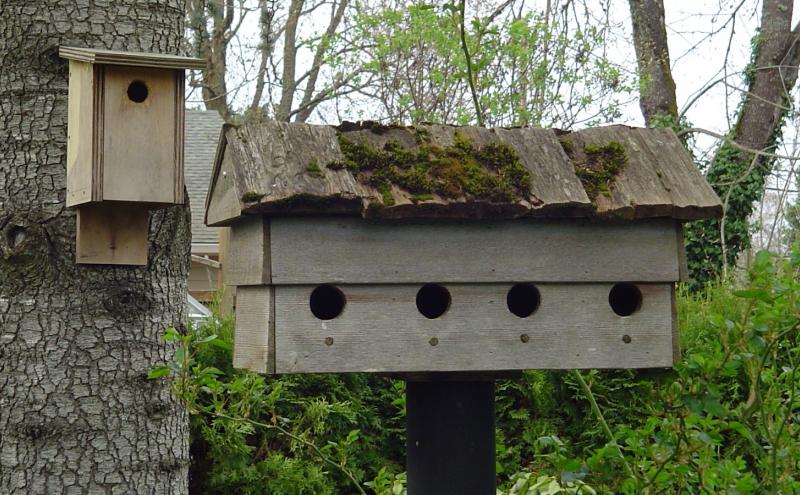As the first property for the Port of Seattle, Fishermen’s Terminal is the center of the long maritime history of our region. And it will soon become an example of the industry’s movement towards innovation and sustainable practices to ensure its long term viability.
Major construction has begun on the Maritime Innovation Center (MInC) on the grounds of Fishermen’s Terminal. The historic Ship Supply Building, constructed in 1916, will be modernized into a 15,000 square foot facility featuring work, fabrication, and event space for new business incubators and anchor tenants. The Port of Seattle will operate the MInC in partnership with Maritime Blue, and host emerging companies that are working to solve maritime industry problems, increase the maritime workforce, and advance blue economy opportunities around the world.
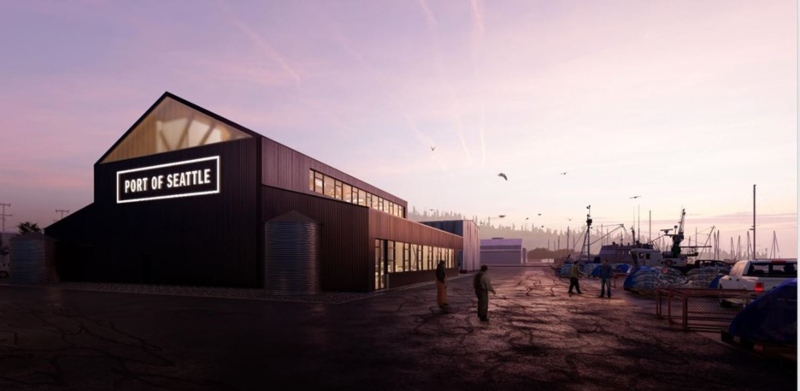
This beautiful and modern facility will be on the cutting-edge of sustainability. The Port and architects at Miller Hull are designing the facility to meet the world’s strictest green building certification, the Living Building Challenge.
Created by the International Living Future Institute (ILFI), the program is billed as “The world’s most holistic and ambitious rating system to create buildings that work in harmony with nature.” (Source: ILFI website). It’s a philosophy, certification, and advocacy tool for projects to move beyond merely being less bad and to become truly regenerative. The ambitious goals of this program can best be summarized by the question posed by the International Living Future Institute:
“What if every single act of design and construction made the world a better place?”
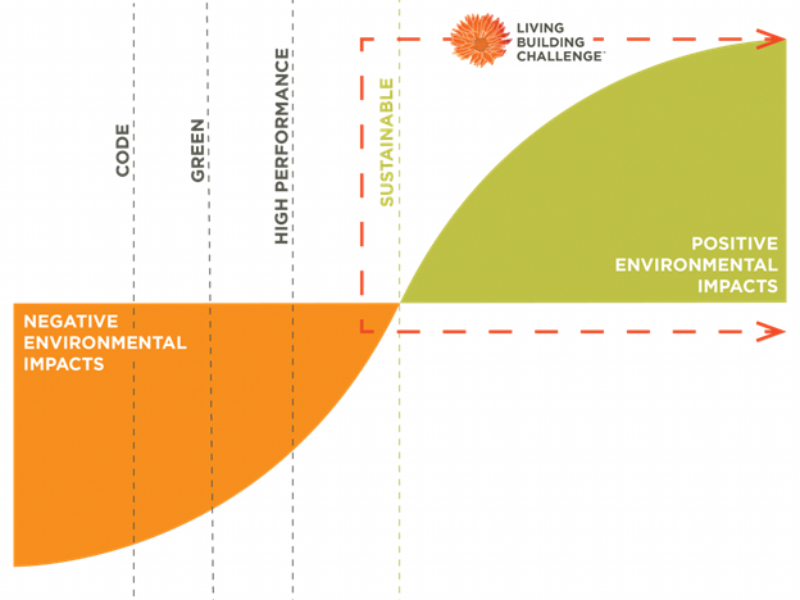
What is the Living Building Challenge?
Living Buildings essentially:
- Generate more power than they use
- Capture and process all water onsite
- Are constructed using non-toxic materials
This certification is an ambitious, performance-based approach with 20 imperatives that must be met for any type of project, at any scale, in any location around the world.
There are seven performance categories, called “Petals” with associated subcategories below:
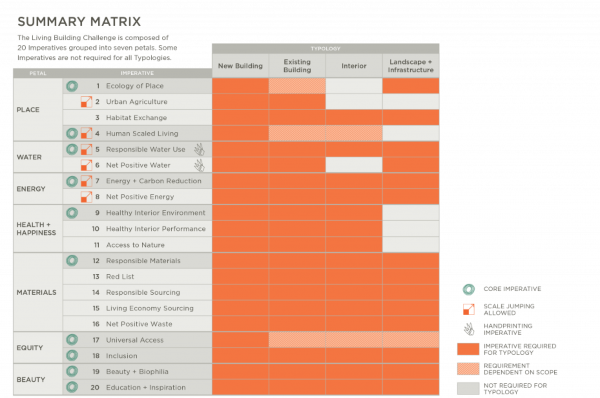
Petal 1: Place
Considering the ecology of the building, adding urban agriculture, recognizing habitat, and reducing the transportation impact
Petal 2: Water
Building responsible water use practices and minimizing water waste
Petal 3: Energy
Relying on renewable resources, reducing energy use and carbon
Petal 4: Health + Happiness
Fostering environments that optimize physical and psychological health and well being
Petal 5: Materials
Building with responsible products that are safe for all species through time
Petal 6: Equity
Supporting a just, equitable world including universal access for all and incorporating public use features like art, gardens, benches, and street furniture. Including diverse stakeholders in the design, construction, operations, and maintenance phases. Or funding a regional, community-based non-profit organization focused on equity and inclusion.
Petal 7: Beauty
Celebrating design that uplifts the human spirit and making the facility open to the public. And educating the public on the design and environmental features of the product through signage, brochures, or websites.
What does the certification mean?
A building can be certified for all elements or they may choose to focus on one petal. Here are the different certification levels:
Living certification
Living certification is for projects striving for the highest level of health, equity, sustainability, and regenerative design. A project achieves Living certification by attaining all imperatives assigned to its Typology.
Core certification
The Core certification pathway lays the holistic foundation for building performance that can be considered sustainable. It requires the achievement of the 10 Core LBC Imperatives (see illustration above).
Petal certification
Petal certification is for projects that want to dive deeply into one or more particular issue areas, or Petals, of the Living Building Challenge. This certification requires, at minimum, the achievement of all 10 Core LBC Imperatives, plus filling all imperatives in one or more of the Water, Energy, or Materials Petals.
How is compliance assessed?
The Living Building Challenge compliance is based on actual, rather than modeled or anticipated, performance. Therefore, projects must demonstrate compliance with imperative requirements over at least 12 consecutive months of operation to verify performance.
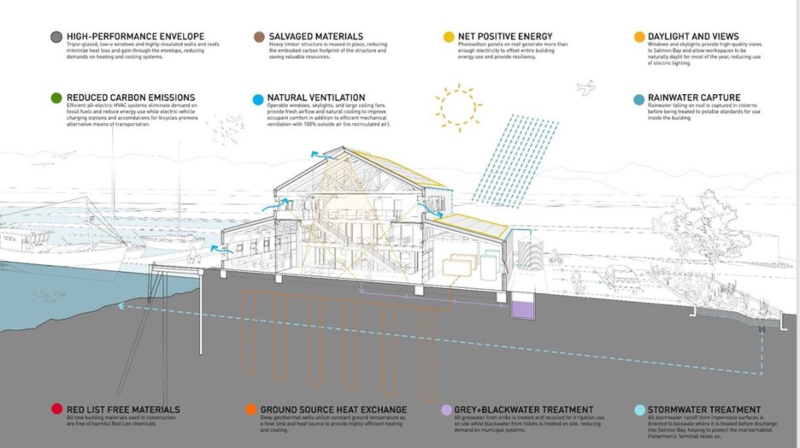
How will the MInC meet the standards?
“The transformation of the Port’s oldest asset into one that can meet the Living Building Challenge symbolizes the Port’s recognition of the maritime industry’s significance to our region’s history and future,” said Port of Seattle Commissioner Fred Felleman.
The MinC is being built for full Living certification and will have its own utility, generate its own energy, capture its own water, and process its own waste. Some of the advanced LBC sustainability and resiliency features include:
- Net positive energy — generating all energy needed to run the facility with photovoltaic cells
- High-efficiency envelope and MEP systems
- Salvaged materials
- High-performance envelope
- Reduced carbon emissions
- Natural ventilation
- Natural lighting and views
- Capturing rainwater in rain gardens and treating it for potable use
- Not using potable water for non-potable applications
- Ground source heat exchange
- Grey and blackwater treatment
- Stormwater treatment
- Red list free materials — using products that do not contain toxic chemicals like asbestos, formaldehyde, lead, mercury, and PVC
- Reducing single occupancy trips in fossil fuel vehicles through several methods
“The Maritime Innovation Center will stand as a testament to the Port of Seattle's commitment to sustainability, resilience, and community for generations to come. We look forward to seeing it become a symbol of innovation on Seattle's waterfront, in alignment with the port's mission to become the greenest and most energy efficient port in North America,” said Mike Jones, Architect at Miller Hull.
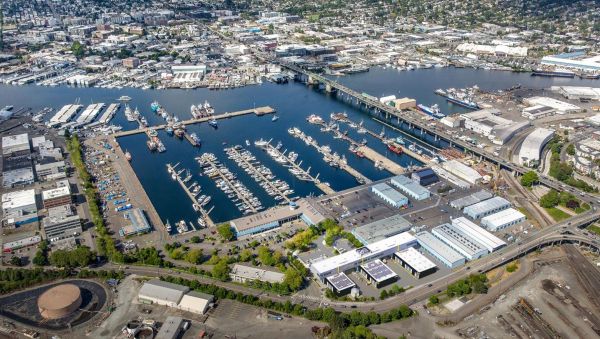
How many Living Buildings are there?
There are currently more than 800 projects certified or registered around the world. Here are just a few of the 14 certified buildings in Washington State:
- PCC Stores in Ballard, Downtown, West Seattle, Bellevue, and Kirkland
- St. Mark’s Affordable Housing
- The Bullitt Center
- King County Parks North Utility Maintenance Facility
- The Block Project/Facing Homelessness
- Watershed Building, Fremont
How is this different from other certifications?
The MInC isn’t the first green building project at the Port. Here’s an overview of major U.S. program certifications and other sustainable buildings at the Port.
Living Building Challenge Certification
- Administered by the International Living Future Institute
- Buildings are evaluated on actual energy use and production and measurement of the indoor environment one year after building.
- The first five Petals of the LBC standard correspond with the LEED certification criteria, but add two more Petals of equity and beauty.
Projects:
- The MInC is the first at the Port to designed for the highest Living certification
WELL Building Standard
- Administered by the International WELL Building Institute (IWBI)
- An evidence-based roadmap to create people-first buildings
- The standard is based upon 10 concepts with features with distinct health intent: Air, Water, Nourishment, Light, Movement, Thermal Comfort, Sound, Materials, Mind, Community
- Buildings are scored by compliance in every concept and feature
Projects:
- The Employee Service Center at SEA Airport, pursuing WELL Gold certification. Project highlights include healthy materials, circadian lighting, ergonomic work stations, and air quality monitoring.
Leadership in Energy and Environmental Design (LEED Certified)
Administered by the U.S. Green Building Council (USGBC) this is the most widely-used green building certification in the world, active in 186 countries and territories with 197,000 projects worldwide. LEED certification provides a framework for healthy, highly efficient, and cost-saving green buildings, which offer environmental, social, and governance benefits. Building sustainability is tested through simulations and projects are awarded certification levels based upon a points system.
In the quest to be the greenest and most energy efficient port and airport in North America, the Port of Seattle has several LEED-certified buildings completed and in progress:
Completed Projects:
SEA Airport Rental Car Facility (RCF)
The Rental Car Facility, built in 2012, was the first LEED-certified building at the airport and Port, and was the largest consolidated rental car facility in the nation to be certified Silver.
Sustainable features include: natural ventilation, high efficiency lighting throughout, regionally sourced construction materials, Forest Stewardship Council (FSC) certified wood, and construction materials with recycled content. During construction, 97% of construction waste was recycled.
International Arrivals Facility (IAF)
As part of the Port of Seattle’s emphasis on environmental stewardship and sustainability, SEA Airport’s International Arrivals Facility was designed to achieve LEED Silver certification.
N Concourse Modernization
From harvesting rainwater to heating the facility with renewable natural gas (RNG), these green features helped SEA Airport’s N Concourse Modernization project achieve a Leadership in Energy and Environmental Design (LEED) Silver certification.
Salty’s at the SEA and BrewTop Social
This is the first tenant LEED project inside SEA Airport to achieve LEED certification, featuring a space that uses as little energy as possible through conservation and efficiency.
Projects in progress:
C Concourse Expansion
The C Concourse Expansion at SEA Airport is the first project of its kind to follow the Port’s Sustainable Evaluation Framework, a process to transparently evaluate alternative, sustainable approaches to build capital projects where environmental and societal impacts inform project design, alongside cost and schedule. The project is targeting LEED Silver certification and will be completed in 2025.




